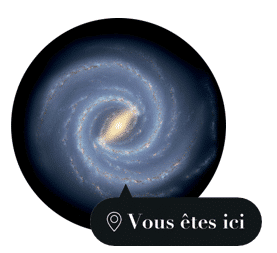Embark on a fascinating adventure through the solar system—without leaving Earth! Your journey begins at Mont Caly, where the Sun is represented by a sleek metal structure.
Using a scale reduced to one billionth, the planets and their actual distances are accurately represented at a human scale, allowing you to explore the solar system as you walk. The trail is accessible and gently sloping, offering an enjoyable and educational experience with breathtaking views of the mountains.

| Short route | Long route |
| Duration: approx. 2 hours Distance: 5.7 km | Duration: approx. 3h30 Distance: 8.9 km |
A journey at the speed of light… or almost!
Each step you take equals 1 million kilometres—that’s 25 times around the Earth! At this scale, Neptune, the final planet on the trail, is located 4.5 km away in the hamlet of Lassarre. In comparison, a space probe would take 20 years to cover this distance from Earth!
To shorten your return journey, a second Neptune station awaits you on the lower path, near Uranus (accessible via the Mont Chéry gondola).
Along the way, each planet is displayed atop a post, accompanied by an information panel and a QR code to learn more.
Ready for lift-off? At the end of your journey through the solar system, test your knowledge with a short quiz! If you get a perfect score, a small reward awaits you at the Tourist Office.
The Components of the Solar System

The Milky Way is the name of our galaxy. Home to our solar system, it contains 100 to 400 billion stars. To this, we must add as many planets. At the heart of the galaxy lies Sagittarius A*, a supermassive black hole.
The Sun
It is a ‘yellow dwarf’ star, a medium-sized star in a stable state, located at the center of the solar system. It accounts for about 99.8% of the total mass of the solar system. The Sun produces energy through nuclear fusion, converting hydrogen into helium.
Comets
These are small bodies made of ice, dust, and rocks. They orbit the Sun on very elliptical paths. When a comet approaches the Sun, the heat melts the ice and creates a tail of gas and dust.
Asteroids
These are small rocky bodies that mostly orbit between Mars and Jupiter in a region known as the asteroid belt.
Planets
Eight major planets orbit the Sun, all nearly in the same plane called the ecliptic. Starting from the closest to the Sun, they are:
- Mercury
- Venus
- Earth
- Mars
- Jupiter
- Saturn
- Uranus
- Neptune
| Orbital Period | Distance to the Sun in millions of km (in meters on the Trail) | |
| Mercure | 58j 15h | 58 |
| Venus | 243j 26min | 108 |
| Terre | 23h 56min | 150 |
| Mars | 24h 36min | 230 |
| Jupiter | 9h 55min | 780 |
| Saturne | 10h 33min | 1400 |
| Uranus | 17h 14min | 2900 |
| Neptune | 16h | 4500 |
The first four are terrestrial planets, rocky and dense, while the last four are gas giants, primarily composed of gases and liquids.
Natural Satellites
Each planet in the solar system, except for Mercury and Venus, has natural satellites that orbit around it. Earth has one Moon, while Jupiter and Saturn each have dozens.
Meteoroids
Meteoroids are small rocky objects that enter Earth’s atmosphere and burn up due to friction with the air, creating shooting stars.
Overall, the solar system is a fascinating example of how gravity and the laws of physics interact to form and maintain complex planetary systems.
